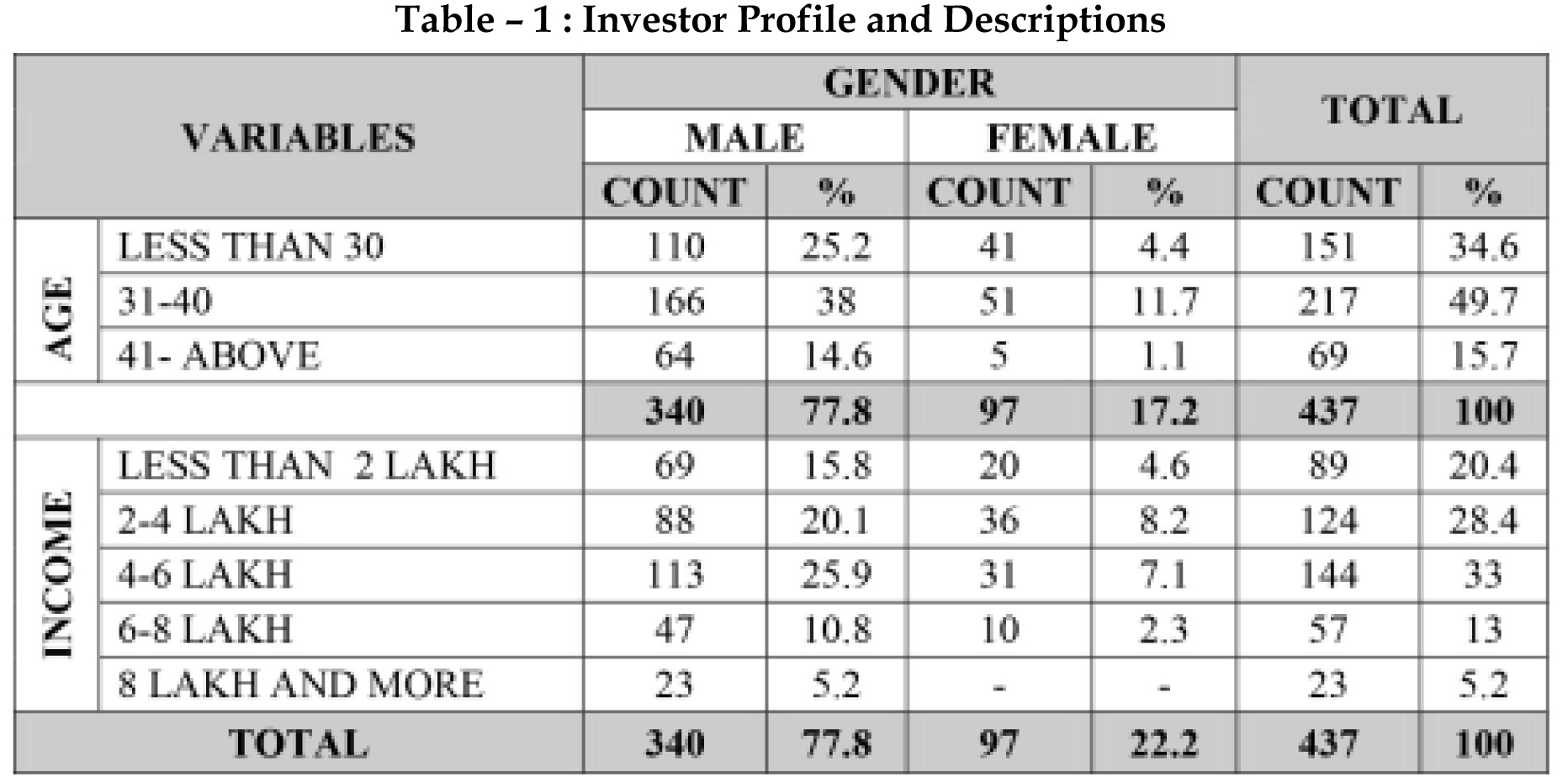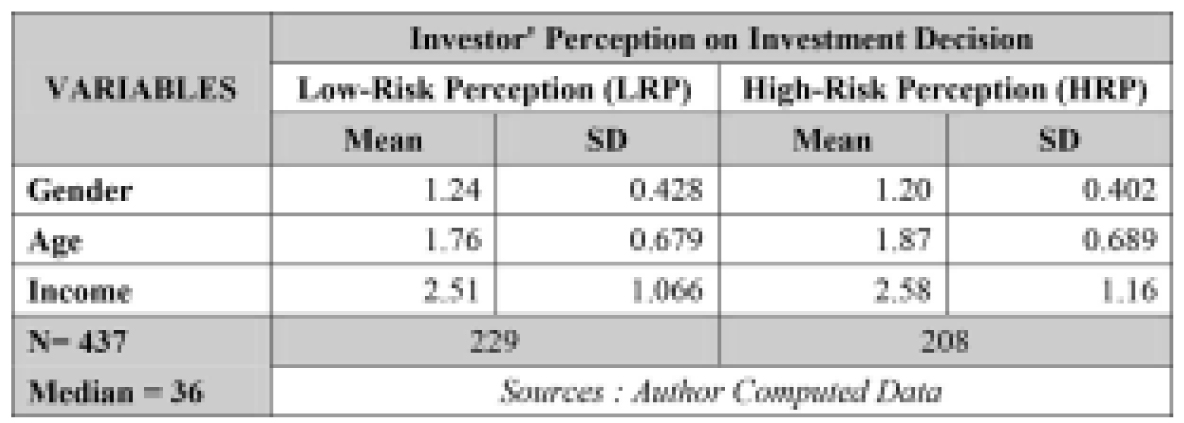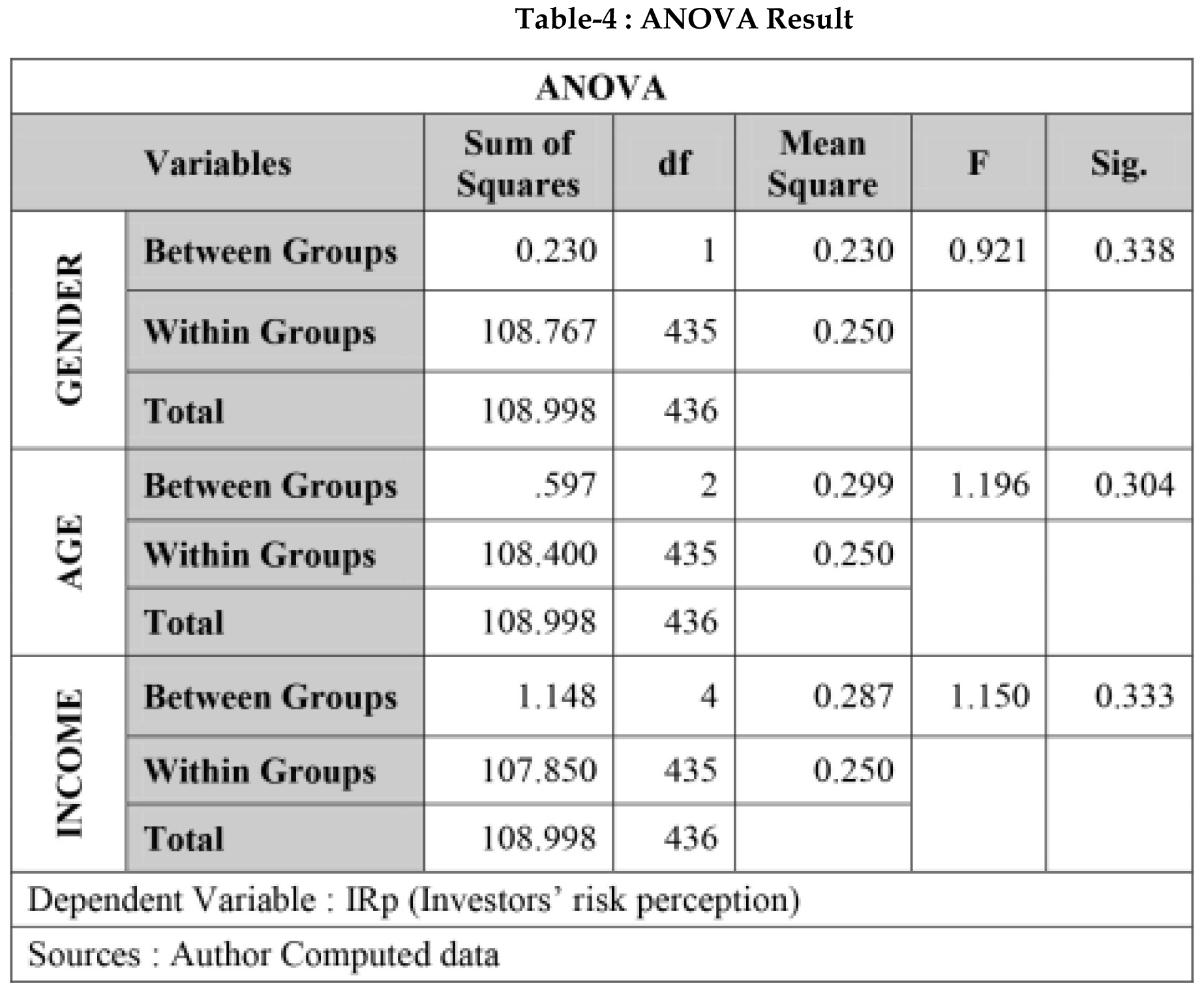Subscribe now to get notified about IU Jharkhand journal updates!
Effect Of Gender, Age And Income On Investors' Risk Perception In Investment Decision : A Survey Study
Abstract :
The present research focuses on the behavioural aspect of investment, which tells that the investment decision varies with the uncertainty of the situation and the perception of the individual at different risk level. The risks are categorised by different class of people of sex differences, age differences and different income groups. These individual groups directly or indirectly associated with the perception of individual risk level in decision making. Based on this the present study tries to investigate the effect of gender, age and income differences on investors' risk perception in investment decision in the Indian context. Delhi-NCR region is the primary location of the study for data collection with the help of a questionnaire method. The finding of the study says that there is no significant difference in investors' risk perception among the different independent groups.
Keywords :
Risk, Risk perception, investors, Investment decision.Introduction :
The advancement in finance proliferated the introduction
of behavioural finance as a new discipline, which mainly
deals with investors' biases and psychological factors. The
factors caused investment decision making nasty
sometimes. The principal cause of this nasty behaviour is
that “the investors' act irrational” (Shiller, 2000), by its sex,
age and income. Apart from these, the foremost cause is
the individual investors' himself and his level of risk
perception which intervene the investment decision
making. In other words, the investors' risk perceptions are
influenced by its social emotion which affects the
investment decision making. In behavioural finance
(Slovic, 1987), risk perception is defined as the subjective
judgments which relates to how much people know about
and understand risks. Similarly, Bairagi et al., (2018) say
about the concept "Risk perception" which defines the
way retail investors' view the financial risk basaed on
expert knowledge and experiences that acquired from a
different class of people.
In this study, we investigate systematic differences of risk
perception between groups. In particular, we study the
interaction of risk perception of an individual with the
gender, age and income of the decision maker. The
common stereotype is that women are more risk-averse
than men, people of young age are more proactive in
investment. Therefore, the financial risk or the perception
acquired from a different class of people is characterised
by sex differences, age differences and individual income
Palash Bairagi1 Dr. Anindita Chakraborty2
differences which we called the socio-economic factor.
These factors are influences the investment decisions due
to their perception of risk toward investment. In other
words, we can say that investors' risk perception involved
with the differences male-female character, age variation
and the income figures. Take some previous context who
says that “is men more willing to perceive or take the
financial risk than women?” (Charness et al., 2007)
answered this question by concluding that women make a
smaller investment than the men do and they appear to be
more financial risk averse.
Furthermore, the novelty of the study gearing to improve
the clarity of the study by deep investigating the
significantly difference of the individual perception in
investment decision among the groups. While doing so,
most of the data were collected not for gender, age or
income valuation but for satisfying the research
hypothesis in below. Therefore, the study fulfilling the
criteria of gender, age and income of individual investors'
perception towards investment risk and their relation.
With this, the present study extended with some extensive
literature review, objective and hypothesis framework,
methodology and analysis and discussions in below.
2. LITERATURE REVIEW
The existing literature in the area of effect of gender, age
and Income on risk perception and it relates to the
investment decision making. The discussion supports
some of the critical summaries of the literature reviewed
which paves the way for the study which includes with the
concept of risk in investment decision making. Lopes
(1987) defined risk is a situation where decisions are made
from consequences whose, future events having known
probability. It involves a factor of uncertainty and a
potential loss (Kaplan and Garrick, 1981). Further,
Wildavsky and Dake (1990) defined psychology of risk is
the ability to predict and explain what kind of people will
perceive potential hazards to be how dangerous. In
another word, it is a psychological aspect of risk
perception that studies behavioural finance and the biases
(Ricciardi, 2008).
Weber and Milliman (1997) experimented that risk
perception of investors and the choices are related to each
other which gives same preferences for perceived risk in
both the series of decision making. The authors also tried
to find out the factor that changes and affects choices
which in turn also affects risk perception.
Madhumarthi (1998) suggested that the preferences of the
investors and their perception about the risk in the Indian
markets. Three classes of investors had been identified
based on their risk perception namely, risk seekers, risk
bearers and risk avoiders. The result showed the operating
performance of the companies influenced the investors.
The risk perception changed the investment decisions of
the investors and the profit earned by them.
Olsen and Cox (2001) studied the influence of gender
perception and their responses on investment risk where
social and technological hazards is an extensive evidence
which includes the factors as age, education, wealth and
experience for determining the answers to investment risk
for both genders are different from each other or not and
their perception level. The evidence on the existing
literature of gender differences in financial decision
making stems from the behavioural studies. The
consensus on the size of the gender differences and the
methodical consistency of the study (Powell and Ansic,
1997).However, in the case of behavioural finance study of
general investors, Gender is the most important
explanatory factor that affects the confidence in the
investment decision. If we look back to some traditional
literature like Lewellen et al. (1977) who said that gender
differences had been associated with the types of financial
information possessed and the use of such information
directly or indirectly influences the investors' decision
making. More likely, Estes &Hosseini (1988) also said that
women have significantly lower confidence in an
investment task than men, Similarly after controlling for
all other relevant variables and characteristics including
the amount of the investment decision.
Garbarino and Strahilevitz (2004) examined that men and
women differ in their perception of the risks which
associated with the shopping online and its effects.
Similarly, they also discussed the gender differences in the
effect of receiving a recommendation from relatives,
friends on perceptions of online purchased risk. They
further compared the men women willingness towards
the investment in online. The result revealed that women
perceived a higher level of risk in online purchasing than
the men.
Similarly, Age exhibits the investors' risk perception and
the financial decision over the life cycle and implications
for regulation by Agrawal et al. (2009), who said that the
average person peak financial decision making age is
around 53 years of old. In contrary to this Goetting and
Schmall (1993) noted that the ability of investors to make
sound financial decisions which associated with the
gaining financial knowledge. To make sound financial
decisions increases sharply in the age of 20 years to 30
years of old, the levels off and peak in the 50 years of old,
then it begins to fall sharply on 70 to 80 years of old.
Onsomu (2015) identified the effect of age on investors'
decision at the Nairobi Securities exchange where the
respondent in the age bracket of 18-30 years, 31-40 years
and 41-50 years respectively were affected investors
decision to overconfident bias. The finding depicted that
age differences have a significant effect on the level of
overconfident bias among the participants. Further, the
author concluded that the most affected investors are in
the age bracket between 31-40 years of old.
In case of Income, which we can be called it socio-economic
factor, Lutfi (2011) explained the relationship between the
demographic factors like such as gender, age, marital
status, education, income, and family members, and
investor's risk tolerance as well as investment preference.
The author resulted that the respondent with income of at
list 10 million, puts most of their money in capital market
instruments than the that of the respondent with an
income of less than 10 million tents to put their money in
bank account. Therefore, they concluded that low-income
investors tend to save their money in a bank account which
indicates that the income affects the investors' risk
behaviour.
Ansri and Moid (2013) explained the crucial factors that
affect investment behaviour of young investors' on which
the study inferred that majority of investors invest for
growth and additional income and the primary factor that
guides their investment decision is a risk factor which
means that investors mostly are risk-averse.
Similarly, Prakash et al. (2014) studied the different socioeconomic
classes which influence the risk decision
behaviour in Karachi. The authors also said that investors
in Karachi are particular about their future market
condition and hence they are reluctant to take risk decision
and invest in less risky assets. Similarly, regarding socioeconomic
factors, the investors with high income prefer
more risk than the investors' with less income.
Furthermore, they also exhibited that the people with
higher level of education prefer higher risk than the
investors have a low level of education.
3. THE OBJECTIVE OF THE STUDY
The objective of the present study is to investigate the
effect of gender, age and income on investors' risk
perception in the investment decision.
Hypothesis framework :
For Gender
Ha = There isa significant relationship between the effect of a
gender on investors risk perception in the investment
decision.
For Age
Ha =There is a significant relationship between the effect of a
ageon investors risk perception in the investment
decision.
For Income
Ha = There is a significant relationship between the effect of a
income on investors risk perception in the investment
decision.
3. METHODS AND PARTICIPANTS
The present study is exploratory cum descriptive in
nature. Both secondary and primary sources of data were
used for the research. The secondary data were collected
for the support of various questions such as what supports
the determinant of risk perception. The primary data were
obtained from conducting the retail investors' survey with
437 filled responses, through self-designed questionnaire
method, the survey was also conducted from the
geographical area of Delhi NCR region. The Questionnaire
was divided into two parts. In the first part, the questions
were directly related to demographics like the gender, age,
income. In the second part of the questionnaire,
respondents were asked to give their responses on fivepoint
Likert scales of ten statements of risk perception. In
the given scales 1 indicates "Strongly disagree" 2 is
"disagree" 3 is "undecided" 4 is "Agree" and 5 indicates
“Strongly Agree". Of The reliability of the investors'
perception in investment decision making are measured
by calculating Alpha Coefficient of 0.72, often items,
which satisfy the criteria of further study. The criteria for
the selecting the responses are judgmentally basis, where
the presumptions are made from retail investors'
perception and experience towards their investment
decision making. Based on the above criteria we calculated
the median value from all sum of respondents for
categorising the investors' risk perception in investment
decision (i.e. Low risk perception (LRP)< Median Value
Table.1 describes the investors' profile and the personality
of the investors' which includes gender, age groups and
inc ome g r oups . Re g a rding Gende r a g e and
incomedifferences,the study forgo with the 437
participants responded the full questionnaire in the retail
investor survey, out of which 77.8 per cent (i.e. 340) of
respondents were male and remained 22.2 per cent (i.e. 97)
of the sample respondents were female. Thus, the result
indicates that female participant in the investment front is
still away from the male opponent.
Based on the research objective the effect of gender, age and
income on investors' risk perception in the investment
decision and the hypothesis. The study found that male
respondents (77.8 %) are more than the female (22.2%)
shown in investors profile table no.1. For the hypothesis as
concern ANOVA result shows in terms of gender that there
is no significant difference in risk perception of male and
female in investment decision. Similarly, for age groups,
there is no significant difference among different age group
in risk perception of investors 'in decision making. For
Income group, it is found that there no significant
difference in investors' risk perception in different income
groups in investment decision. This is because the
significant score in ANOVA results (Table no.4) for the
entire three independent group variable i.e.0.338, 0.304 and
0.333 for gender, age and income are more than that of the
.05 % of significant. Therefore, the result of all three
variables like gender, age and income shows a similarity in
the mean scores on the dependent variable. Hence, all the
three independent variable gender, age and income are
failed to accept the null hypothesis for dependent variable.
By looking into the objective of the study, the present study
concluded that the effect of gender, age and income are
adversely affected investors' perception, which is shown in
the literature review. However, in this study, the mean
score for equality of variance are same for age groups and
between income groups as compared to gender, which
shows the inequality of mean score between male and
female Hence, it can be said that the independent
grouping variable like gender, age and income does not
affect so much to investors' perception towards risk as the
study is statistically significant among the dependent
group variable. While looking into the investor profile, we
can also make differentiate among male participants are
more advanced than the female participants in investment
matters. In terms age differences the level of risk remains
the same for investors' perception in investment decision
for age groups.
5. ANALYSIS AND DISCUSSIONS
5.1. Description of Investor profile.

In case of age of respondents, 49.70 per cent of majority
investors were in the age group between 31-40 years of old,
as compared to others like 34.6 per cent in between 30 years
(less than 30) and 15.8 % were more than 40 years of early
investors'. The cross-tab analysis results between age and
gender reveals that 38 per cent of the male respondents
were under the age group of 30-4 years of old followed by
25 per cent (less than 30) and 14.6 per cent (40-above) as
compared to female respondent of 11.7 per cent (31-40), 4.4
per cent (less than 30) and 1.1 per cent (40-above).This
indicates that the age group between 31- 40 years of old is
more prone towards investing into stock.
5.2. Descriptive Statistics.
Table.2. Descriptive statistics of Investor' risk perception
on investment decision.

Table.2. Describes the descriptive statistics of investors risk
perception on investment decision which is categories as
low-risk perception, which can define as the
investors'who's'average score below the median valueare
called low-risk perception and the investors' whose
average score are above the median value is called highrisk
perception, among the different independent
variables. The table also says out of the total sample of 437
respondent. Out of which 229 respondents have a low-risk
perception in investment decision making with the overall
mean value of the different independent categorical
variable with gender 1.24 (SD of 0.428), age 1.76 (SD of
0.679) and income 2.51 (SD of 1.066). As compared to that of
the mean score of all the respondents who perceive high
risk on investment decision in different groups like gender
1.20 (SD of 0.402), age 1.87 (SD of 0.689) and income 2.58
(SD of 1.16).
5.3. Homogeneity of variance among the independent
variable
Table-3 : Levene's test of equality of variances

Dependent Variable : IRp
Sources : Author computed data.
Table.3. Depicted thehomogeneity of variance among the
independent variable like gender, age and Income with the
dependent variable of investors' risk perception (IRp). The
assumption of Levene's test of equality says that the
significant values for two independent groups' variable are
more than .05, which is.380 and .108. This indicates that the
equality of variance exists among the age and income and
the mean score of all categorical of the independent
variable is same. Therefore, we can say that there is no
significant difference between the age and income
categories on the dependent variable, i.e. the investor risk
perception. In the case of gender, the significant value is
less than .05 which is .023. This indicates that the theory of
euqality in gender difference are not same with the mean in
risk perception which means male and female in the
investment decision have different risk perception.
5.4. The result of Analysis of Variances (ANOVA)

Table-4 : Describes the ANOVA result of between group
and the within groups of the different independent
variable like gender age and income. The result shows that
the significant value is greater than 0.05 % level of
significance among different independent variables like
0.338, 0.304 and 0.333 for gender, age and income which
means we fail to accept the null hypothesis.6. FINDINGS.
7. CONCLUSION.
Regarding Income, sometimes individual income does not
affect the perception of the investor. Because it is not
necessary that one has the high income, he or she should
look high risk or vice-versa. At the end, the study also
concluded that for the fulfilment of the objective that the
effect of gender, age and income on investors risk
perception in the investment decision. However, in general
terms of individual investors' perception are almost similar
in conceptually, but in practice, the situation is something.
else, personal risk differs with the uncertainty of time
frame and domain knowledge that may be by different
race and class of individual.8. REFERENCES
